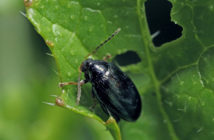Avadex Excel 15G (tri-allate) can be used in winter or spring linseed as an EAMU. Spring cropping will increase this year– firstly moving away from winter oilseed rape which, quite apart from establishment issues, has become less profitable with variable yields, low prices and increased input costs; secondly to control black-grass more effectively across the rotation and finally to satisfy the Three Crop rule. But the spring crop chosen needs to be profitable in its own right and be easy to grow. Spring linseed now falls into this category with the new EasyCut varieties from Premium Crops.
Nigel Padbury, Seeds and Marketing Manager for Premium crops, reports that spring linseed has one of the highest Gross Margins of any spring crop. “Its Gross margin in 2017 is calculated to be £533/hectare compared with £458 for spring oilseed rape and £388 for feed spring barley. It is certainly much more profitable than the pulses which are said to be increasing in area this year but which have GMs of below £300/ha. If you have decided to move away from a dominant winter crop rotation and introduce some spring cropping, which many farmers have decided to do this year, and then it makes sense to choose the crop that makes you the most money.”
Nigel saw an upsurge in the area of linseed grown last year. According to the Defra June 2016 census, 27,000 ha’s of linseed were grown and a further increase is expected this year. “Certainly of the 400 or so growers we know, many are continuing with linseed,” says specialist linseed agronomist from Premium Crops, Sam Deane.
“Most of them know how to grow the crop now and they do it properly and well. The average yield is 2.5 t/ha but some growers grow 3 t/ha. This with a price of £350/t, low imput costs and contracts make linseed a profitable option. With the ultra-high Omega-3 variety, VT50 “Nulin”, the price could be even higher.”
“We also understand more and more about the crop’s agronomy and are trialling growth regulators and nutritional programmes. We have found that growing linseed reduces slug populations in following crops. It doesn’t suffer from Cabbage Stem Flea Beetle so reduces this pest pressure too. By improving fertility, wheat yields after linseed seem to be higher,” says Sam.
“Spring linseed lends itself to an effective cleaning crop when it comes to difficult to control grass-weeds such as black-grass, wild-oats or brome. The crop is sown late from the end of March through to late April, so that growers will have several opportunities to spray off grass-weeds with glyphosate in a stale seedbed. Then Avadex Excel 15G (tri-allate) can be applied pre-emergence, followed by Centurion Max (clethodim) post-emergence if required,” advises Sam.
“Avadex is being used widely in weed control programmes to help in the control of black-grass, rye-grass and wild-oats,” says Robert Plaice, technical manager for Gowan. Avadex Granules in the market now, with the MAPP No 16998, have an EAMU for use pre-emergence in winter and spring linseed in addition to its label recommendations for winter wheat, winter barley and spring barley
Nigel points out that the new EasyCut varieties, such as Altess, Duchess, Comtess and Marquise, have a lower fibre content in their stems making harvest easier. Their early maturity means that the harvest fits in nicely behind the wheat in late August to early September,” he says.
Sam Deane says that many growers are disenchanted with winter oilseed rape and with the level of black-grass populations on their farm, so they are actively seeking a crop with fewer issues or problems and one in which black-grass populations can be reduced. “I think spring linseed ticks both these boxes. Despite having at least 25% less fibre in the stems, the EasyCut varieties are short, stiff strawed and stand well. Another important characteristic is that linseed has a fantastic rooting system that punches through any pans and helps soil structure.”



